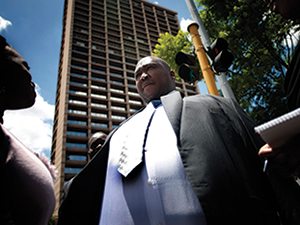
[miningmx.com] – ON A RECENT Tuesday, jobless miners were sitting on street corners, waiting for news about outstanding pay.
At one of the only properties with running water, people were queueing with buckets and containers at an outside tap.
Almost nobody has electricity, as few can afford the R3,000 monthly rental charged by the developer who is buying the village. The soup kitchen at a local church offers the only relief.
With many of South Africa’s gold mines expected to close over the next decade as declining ore grades and rising costs make deep-level underground mining unprofitable, thousands more workers, like their colleagues at Blyvooruitzicht (Blyvoor) near Carletonville west of Johannesburg, are likely to be left destitute.
Changes to the regulatory environment, particularly the rules that govern liquidators, are needed to offer more protection to workers and to ensure assets are sold to buyers with the necessary resources and business expertise, said Gideon du Plessis, general secretary of Solidarity.
Du Plessis took legal action and played a key role in highlighting the abuses in the liquidation of Pamodzi Gold between 2009 and 2011, when politically connected Aurora Empowerment Systems took over its Grootvlei and Orkney mines.
Aurora’s directors, which included Zondwa Mandela and Khulubuse Zuma, and their business partners, Thulani Ngubane and Fazel Bhana, face claims of nearly R2bn for the destruction of the mines’ assets, illegal gold sales and the non-payment of workers while they were in control of Grootvlei and Orkney.
“Liquidators will sell assets for the highest possible price, as they get a percentage of the purchase price.
“Insolvency laws should be changed so that the aim is to sell the business to a buyer who can run it sustainably; to people with the necessary track record and expertise,’ he said.
Instead, liquidators do not seem to do even the most basic due diligence on prospective buyers. In the case of Blyvoor, liquidators named Goldrich Holdings the preferred bidder. At the time, it was hardly 10 months in existence and court documents show that it likely did not have a VAT number or even a bank account.
It missed its first payment deadline a day after signing the purchase deal in December, raising questions about its ability to not only cough up the price tag of R70m to buy Blyvoor, but also to cover security costs and water-pumping duties at Five Shaft, which cost around R5m a month. AngloGold Ashanti is pumping water from two other shafts to prevent flooding of its adjacent shafts.
The liquidators also did not establish the track record of Ngubane and Bhana, who was running Goldrich, along with director Bongani Mthetwha, until it was placed under business rescue in February. It took the liquidators nearly four months to obtain a court ruling that the deal with Goldrich has lapsed.
“Even a basic Google search would have showed Bhana and Ngubane’s link to Aurora. I am absolutely speechless at the fact that they could be named the preferred bidders of Blyvoor.
“It shows again that there is an absolute lack of ethics in the liquidation industry. There should be a statutory body that regulates the industry,’ Du Plessis said.
Equally concerning is the lack of urgency to prosecute directors in cases where there is evidence that directors were negligent in their running of the company, or where fraudulent activity took place, he said.
Three years later, legal processes are still underway to wind up the Pamodzi and Aurora estates and no criminal prosecution has taken place.
One lawyer who is working on the Aurora liquidation said the company had very limited financial records, making it almost impossible to prove valid claims. A lack of assets in the Aurora estate also makes it hard to afford legal costs and the work of a forensic auditor, further delaying the process.
At Blyvoor, claims against Goldrich for damage to the mine’s assets, particularly its processing plant, and the removal of assets may be hard to prove. Illegal mining has thrived in the area since Village Main Reef halted funding at the end of July 2013, and a large turnover of security companies, partly due to non-payment by Goldrich, allowed the zama zamas (illegal miners) to operate with impunity.
An estimated 40 people have been murdered at Blyvoor since December, evidently related to turf wars between different groups of illegal miners.
Two of Blyvoor’s managers face criminal charges related to gold nuggets and gold-bearing material found in their possession.
“I can tell you now where you can get the best price – this week Bekkersdal is paying the most.
“Everybody knows who the buyers are, who the kingpins are. This is classic organised crime,’ said one private security expert who is investigating illegal gold mining around Gauteng.
“There is a lack of capacity in the police; they have lost a lot of skilled people. Then there is also just good old corruption – cops are getting paid off; people are getting warned before raids,’ he said.
Next door to Blyvoor, Sibanye Gold is spending up to R75m a year attempting to contain illegal gold mining, an issue CEO Neal Froneman said is “totally out of control’ and in need of intervention by the South African National Defence Force.
Illegal mining cost the country an estimated R7.5bn in lost revenue last year according to the Chamber of Mines, up from R6bn in 2010. An estimated 14 000 people are involved in the industry.
Despite various threats by former mines minister, Susan Shabangu, to clamp down on zama zamas, the South African Diamond and Precious Metals Regulator did not make one referral to illegal gold mining in its latest annual report.
Spokesperson, Dithuso Kgari, said the regulator’s inspections focus mainly on refineries of jewellery scrap, and it is not aware of any refineries operating without a licence.
It hasn’t done joint inspections with customs but has held workshops with officials at ports to educate them on licensing procedures, Kgari said. It is understood that most of the illegal ore is exported to refineries abroad, and then enters the legal trade.
“While most countries in the world do not regulate precious metals, South Africa has been regulating the precious metals industries for decades.
“We consider the regulation of the precious metals industries through legislation such as the Precious Metals Act as best practice,’ he said.
ACID MINE DRAINAGE
Illegal mining also contributes to some of the industry’s biggest environmental headaches, with the zama zamas’ underground activities and reworking of mine dumps and tailings dams contributing to acid-mine drainage (AMD).
AMD occurs when water that floods previous mine areas becomes infiltrated with chemicals, such as uranium, and leaks into rivers.
With an estimated 6,000 abandoned mines in the country, the AMD problem has reached crisis levels in the Witwatersrand basin, where significant gold mining has taken place over the past century.
Treating AMD is expensive, and a lack of environmental legislation until the 1990s meant that mining companies operated for many years with impunity.
The Department of Water Affairs (DWA) estimates it will cost an estimated R9.5bn to address the AMD problem in the Witwatersrand’s eastern, western and central basins.
Holding companies financially responsible and finding funds from the National Treasury to pay for long-abandoned mines are some of the issues regulators are struggling to address, and the bulk of the long-term financial burden will likely fall on end-users.
“Mines can deal with AMD while they are operating. The real long-term issues related to AMD only become apparent post mine, and the generation of AMD can continue for decades.
“I don’t think we have a solid understanding of the long-term post closure allowance needed (to treat AMD),’ said Golder Associates’ Andre van Niekerk.
Placing a mine under liquidation once operations are marginal is an easy way to abandon environmental and closure responsibilities, said Solidarity’s Du Plessis.
At Grootvlei, financial constraints led to the release of contaminated water into the Blesbokspruit.
At Blyvoor, various environmental breaches have taken place since Village Main Reef placed the mine under liquidation, including the flow of contaminated water into the Wonderfontein Spruit and the Boskop Dam, a key water supplier to Potchefstroom, said Mariette Liefferink, CEO of the Federation for a Sustainable Environment (FSE).
While environmental breaches are easy to determine, conflicting laws mean it is not that easy to hold someone accountable once a mine is placed under liquidation. Village Main Reef has referred all questions related to Blyvoor to the liquidators.
While companies have to make provision for environmental rehabilitation once operations cease, loopholes in the various laws mean it is practically impossible for either the Department of Water Affairs or the Department of Mineral Resources to enforce compliance.
Where mining laws require compliance to various stringent requirements before a mine can be officially closed and a closure certificate issued, while the Companies Act allows for a company to be deregistered without the certificate.
Earlier this year, Susan Shabangu, admitted that her department’s hands are largely tied when mines go into liquidation.
While the DMR must give permission for the transfer of mining rights to new owners, it has little room to intervene in the liquidation process.
The DMR’s process is lengthy – a transfer between DRDGold and Village Main Reef, for example, was still not finalised after more than a year – meaning much damage can be caused from the moment preferred bidders take control of mining assets and the DMR’s regulatory disapproval.
Even when companies mine until the end of life, obtaining a closure certificate, which requires an environmental risk report, an application to transfer environmental liabilities to a competent person and a closure plan, is nigh impossible.
None have been issued under current legislation, said Raina Hattingh, senior scientist at Golder.
For the South African government, clamping down on illegal miners, fixing legal loopholes and finding the money to address the environmental legacy of more than a century of mining may be the easy part.
The real challenge lies in tackling the socio-economic crises mining communities face when shafts close and workers are retrenched.
At Blyvoor’s Dutch Reformed Church, one former miner now volunteers at the soup kitchen. A lack of funds meant they had to downscale their activities, now only providing one meal three times a week to needy residents and school children.
“We’ve been looking at various projects to try and create jobs. We worked on a funding proposal for a chicken farm, but were told the industry is very competitive and it is not a viable option, so now we’re thinking of vegetable gardens.
“What we know is that we’ll never get Blyvoor to what it was when people were still mining here.’











